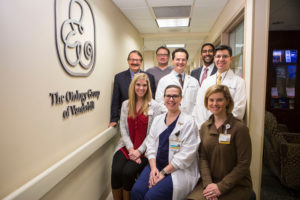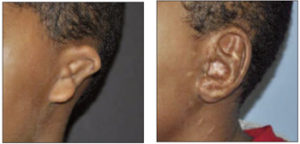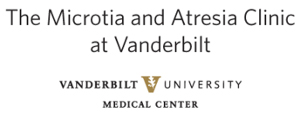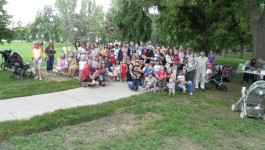
Members of the new clinic for patients with microtia and aural atresia include (front row, from left) Brittney Baugh, Sharon Johnson, R.N., Margaret McRedmond, Au.D., (back row, from left) Ron Eavey, M.D., Scott Fiscus, BCO, Scott Stephan, M.D., Sivakumar Chinnadurai, M.D., and Alejandro Rivas, M.D. (photo by Anne Rayner)
by Matt Batcheldor | Thursday, Jun. 8, 2017, 10:16 AM
Having a child born without an external ear or ear canal can be a scary and confusing experience for parents, and finding medical care for the rare condition has meant having to travel to several distant medical centers for treatment options.
But now the Vanderbilt Bill Wilkerson Center has launched a multidisciplinary clinic for patients with microtia and aural atresia, enabling families to meet with the Vanderbilt clinicians who provide all treatment options for the condition under one roof, on one day. The clinic experience is coordinated by Brittney Baugh and assisted by Sharon Stringer Johnson, R.N.
Microtia and aural atresia are rare, yet highly visible, congenital malformations of the outer and middle ear that affect about one in 7,000 to 10,000 children. Those with the condition can have little or no external ear and no ear canal formed.
“The malformation on the outer ear can come in many forms, from a slightly misshapen top of the ear to the complete absence of any cartilage or skin, with perhaps just an ear lobe present,” said Scott Stephan, M.D., assistant professor of Otolaryngology.
“The ear canal can go from having no opening whatsoever to having a little opening or even having a very tiny ear canal that still is not good enough to transmit sound to the hearing organ, which is in the inner ear,” said Alejandro Rivas, M.D., associate professor of Otolaryngology and Neurological Surgery.
One external ear reconstruction treatment is to recreate the outer ear out of the patient’s own rib cartilage, which is offered by Sivakumar Chinnadurai, M.D., associate professor of Otolaryngology. Another method is soft tissue reconstruction, such as that offered by Ron Eavey, M.D., Guy M. Maness Professor and chair of Otolaryngology and director of the Vanderbilt Bill Wilkerson Center. A newer technique, using an ear-shaped implant covered by the patient’s own tissue, is offered by Stephan. And cutting-edge prosthetics are offered in partnership with Scott Fiscus, BCO, at Precision Ocular Prosthetics in Nashville.

Ear reconstruction — as shown in the before and after photos above — is one of the treatment options available at Vanderbilt’s new clinic for patients with microtia and aural atresia.
Rivas is available to consult on surgical options for hearing restoration in patients with aural atresia, including atresia repair and other implantable technology. Together with audiologist Margaret McRedmond, Au.D., they work hand in hand assisting patients with hearing solutions and devices.
“This interdisciplinary clinic allows me to meet families that may be coming in for reconstructive reasons but I can educate them about how we might be able to help their child hear better too,” McRedmond said.
Added Chinnadurai, “Microtia and atresia are complex and sometimes daunting problems for new parents. It is important for families to get connected early on to understand that they have many excellent options to help their children and we strive to be a resource for families to be able to make the best decision for their child and family.”
In addition to treatment options, Vanderbilt is working to create a community for families of patients with the rare condition by hosting a yearly patient/family oriented conference and picnic, such as the one held last summer.
“The nice thing about that is that there is a good interaction between families,” Rivas said. “When you meet the families of these patients, they all want to know what are the differences and kind of have a personal view of how their cases went and what to expect. In a way, it’s a different way to be able to teach them and orient them on what is the right decision for their children.”
Stephan said the clinic tries to help children as early as possible, for several reasons.
“Children with microtia and atresia have to cope with both hearing impairment in the early years of language development, as well as the social and psychological impact of a congenital malformation that makes them different from their peers.”
Melissa Tumblin is excited about the new clinic. Tumblin founded earcommunity.org, a website devoted to helping individuals who were born with microtia and atresia, and is a consultant for VUMC in the development of the new clinic. She founded the online community after her daughter, Ally, now 7, was born with microtia and atresia and initially found a dearth of information from doctors treating her child.
She said the combined atresia-microtia clinic will offer the best care to both local and international audiences.
“I am looking forward to the new clinic helping so many families” she said. “It’s not just for me, it’s not just for my daughter — it’s for every family who has a loved one with microtia and atresia who would like to know what all of their options are and find the answers they are looking for. I am proud to be a part of the new clinic that is being offered at Vanderbilt.”
Eavey said, “Very few clinicians take on the challenge of caring for these wonderful patients, which creates a geographic challenge for families to engage with experienced individuals in various parts of the country. I have been serving microtia and atresia patients since the 1980s and the talent and the breadth of reconstruction and hearing solutions that we have assembled here at Vanderbilt is unmatched anywhere on the planet — to my knowledge. Historically, from research efforts we have determined that microtia is partially genetic in origin and we later described the first gene.
“We want to learn even more about this condition and anticipate that our systemization efforts will optimize clinical care, educational opportunities and discovery results for these special families,” Eavey said.
Media Inquiries:
Matt Batcheldor, (615) 322-4747
matt.batcheldor@vanderbilt.edu







Leave a Comment
You must be logged in to post a comment.